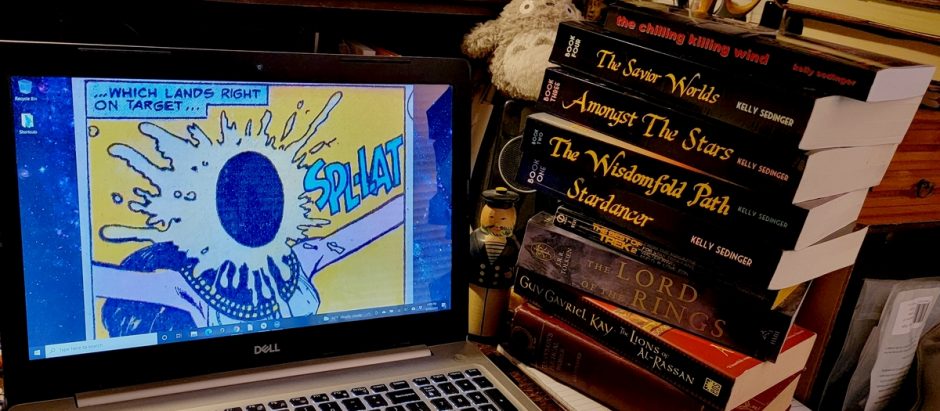I haven’t done one of these quiz-things in a while, so why not? Roger did this one, and now I’m going to appropriate it. (The quiz is from a blog called Sunday Stealing, so the fact that I’m doing this on Monday is right on brand for my “Rules? There are no rules here!” self.)
1) What is your favorite thing about winter?
Snow, I suppose…within reason! In truth, I love winter for being able to wear sweaters, and in general having more options for how to dress; dressing in summer isn’t as flexible because of the need to stay cool and the fact that minimizing layers is best.
I also love darker nights, the winter stars, and the hot drinks (coffee, tea, buttered rum, Tom&Jerry’s) hit better in winter than they do in summer.
2) What is your favorite winter sport?
To watch? Figure skating, I suppose. I also like hiking in winter, and though I haven’t done it in many years, I remember enjoying snowshoeing quite a lot.
3) What is the best winter treat?
I suppose hot chocolate, though I don’t have it very often.
4) What is the earliest time in the year it ever snowed where you live?
To the Google! Apparently in 1956 it snowed on September 20. The earliest I can remember is the October “Surprise” storm, which I believe was somewhere around the 13th or 14th in 2006.
5) What is the best way to stay warm in the winter?
Layers and warm beverages. Hats and gloves. Always hats and gloves!
6) What are your favorite things that are paper?
Books, obviously! But I also love writing on blank paper. And newspaper is great for starting charcoal aflame.
7) What are your favorite things that are cotton?
I assume all of my pairs of overalls are a cotton-based fabric.
8) What are your favorite things that are leather?
I have a pair of gloves that my mother got for me, made to measurement, from a glovemaker in Florence. They’re gorgeous.
9) What are your favorite things that are floral?
The Wife has a growing collection of orchids! She loves orchids to the point that we go to local orchid shows at the Botanical Gardens.
Also, I wish I could find a nice floral print shirt, but everything I ever find in that vein is a Hawaiian shirt, and I don’t want one of those, to be honest.
10) What are your favorite things that are wood?
I have a fountain pen made of wood! And my set of nesting dolls that I got when I was five or six. My bookshelves. And the trees that make up the forests of WNY!
11) What should you do if you think your house is haunted?
I have no earthly idea. BUT, I am acquainted with a local ghost-hunter, so I’d probably DM her and say, “Hey, wanna meet a ghost?”
12) When should you investigate a strange noise in your basement?
Immediately. Any malfunction down there that is significant enough to make a sound you can hear in the main body of the house can not be a good thing. And if it’s the sump pump, you need to get moving fast.
13) How do you know if an abandoned building is safe to visit?
You don’t! That’s the fun of it!
I’ve never actually been one to enter abandoned buildings, to be honest…but construction sites? Those, I’ve been known to explore, though not so much anymore because I’m more keenly aware of what can go badly wrong. But in college, they built a whole new music building, and I explored it in quite a few phases of the construction…including one ill-advised walk along the length of a single support beam with a drop on either side….
14) How do you decide whether to solve a problem as a team or split up and go it alone?
Well, at work I am used to working alone, but sometimes I sense the need to seek help. Now, sometimes it’s plainly obvious that I need help, because I can’t physically do the job by myself. I mean, I only have two hands, and if it’s obvious that the job needs three, then it’s time for help. Another factor, though, is the time factor: sometimes I ask for help because I can do the job myself, but if I do, it’ll take me a really long period of time. Help is necessary for efficiency sometimes. (Now, there are times when I badly underestimate the amount of time needed to get a job done, but that’s a different issue…I think….)
15) Where do you store your knives, and where would you look if one was missing?
We have a drawer where we keep most sharp objects, although we do have a set of knives in a block on the counter. If one’s missing, I look around the kitchen counters and in the sink, I suppose. (Don’t leave knives in the sink, folks. Not a great idea.)
























For International Women’s Day…women!
I should really update this once in a while, but here is an incomplete photographic roster of women I admire. Happy International Women’s Day!